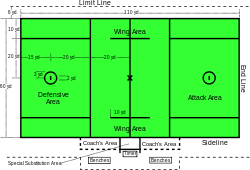There are ten players on each team: three attackers, three midfielders, four defenders.
 |
| Diagram of a men's college lacrosse field |
Each player carries a lacrosse stick
(or crosse). A "short crosse" (or "short stick") measures between 40
inches (1.0 m) and 42 inches (1.1 m) long (head and shaft together) and
is typically used by attackers or midfielders. A maximum of four players
per team may carry a "long crosse" (sometimes called "long pole", "long
stick" or "d-pole") which is 52 inches (1.3 m) to 72 inches (1.8 m)
long; typically used by defenders or midfielders.
The head of the crosse on both long and short crosses must be 6.5
inches (17 cm) or larger at its widest point. The throat of the lacrosse
head for college must be at least 3 inches wide. For high school play,
there is no minimum width at its narrowest point; the only provision is
that the ball must roll out unimpeded. The designated goalkeeper is
allowed to have a stick from 40 inches (1.0 m) to 72 inches (1.8 m) long
and the head of a goalkeeper's crosse may measure up to 12 inches
(30 cm) wide, significantly larger than field players' heads, to assist
in blocking shots.
 |
| A face-off |
The field of play is 110 yards (100 m) long and 60 yards (55 m) wide.
The goals are 6 feet (1.8 m) by 6 feet (1.8 m). The goal sits inside a
circular "crease", measuring 18 feet (5.5 m) in diameter.
Each offensive and defensive area is surrounded by a "restraining box."
Each quarter, and after each goal scored, play is restarted with a face-off.
During a face-off, two players lay their stick horizontally next to the
ball, head of the stick inches from the ball and the butt-end pointing
down the midfield line. Face-off-men scrap for the ball, often by “clamping” it under their
stick and flicking it out to their teammates. Attackers and defenders
cannot cross their “restraining line” until one player from the midfield
takes possession of the ball or the ball crosses the restraining line.
If a member of one team touches the ball and it travels outside of the
playing area, play is restarted by awarding possession to the opposing
team. During play, teams may substitute players in and out freely.
Sometimes this is referred to as "on the fly" substitution. Substitution
must occur within the designated exchange area (often called "the box")
in order to be legal.
For most penalties, the offending player is sent to the penalty box,
which is located between each team's bench. His team must play without
the player for a designated amount of time based upon the foul. (Most
penalties are "releasable", that is, the penalty ends when a goal is
scored by the non-offending team.) Technical fouls (such as offsides and
holding) result in either a turnover or a player's suspension of 30
seconds, while personal fouls are generally penalized one minute. (Some
infractions, such as playing with a stick that does not meet the
specifications of the designated level of play, may serve non-releasable
penalties of up to three minutes). The team that has taken the penalty is said to be playing man down, while the other team is on the man up. Teams will use various lacrosse strategies
to attack and defend while a player is being penalized. Offsides is
penalized by a 30-second penalty. It occurs when there are more than 7
players on the defensive side of the field (three midfielders/three
defensemen/one goalkeeper), or more than 6 players from one team on the
offensive side of the field (three midfielders/three attack). The zones
are separated by the midfield line.
 |
| 1904 Olympics Gold Medal winning Winnipeg Shamrocks lacrosse team |
Lacrosse at the Olympics was a medal-earning sport in the 1904 and 1908 Summer Olympics. Lacrosse was a demonstration sport in the 1928 and 1932 Summer Olympics, as well as at the 1948 Summer Olympics.
The men's professional Major League Lacrosse has used different field
lacrosse rules from the international, college, and high school
programs. With intentions to increase scoring, the league employed a
sixty-second shot clock and a two–point goal for shots taken outside a designated perimeter. In 2007, the MLL was bolstered by a ten-year television contract with ESPN.






